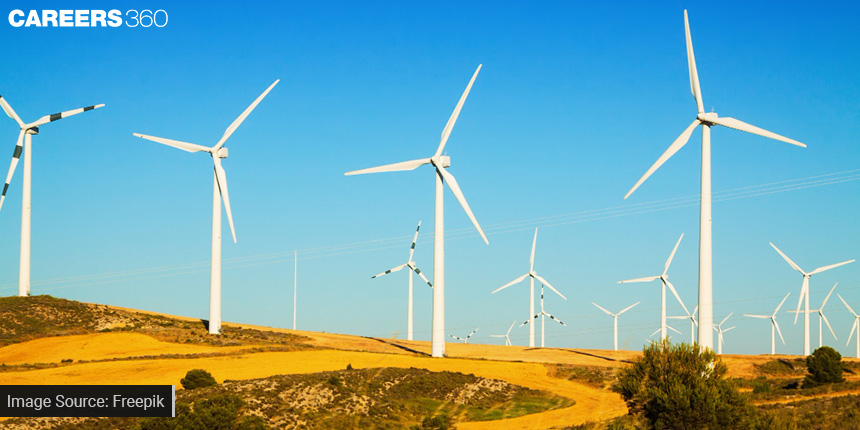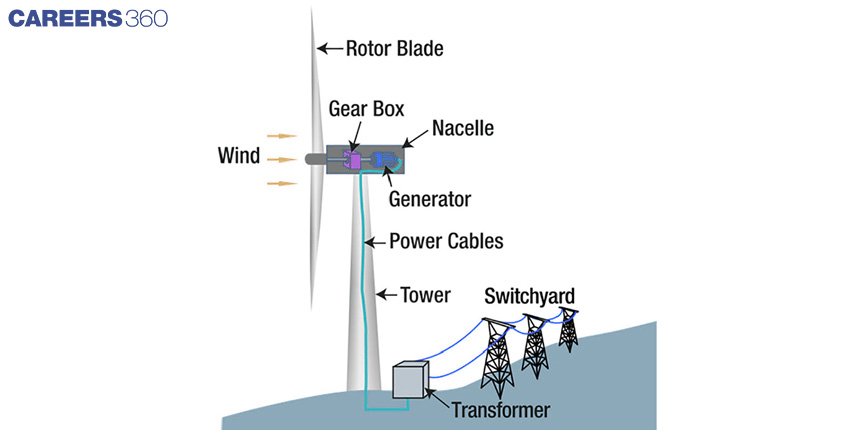Understand How Wind Turbines Generate Electricity
Renewable energy is extremely important nowadays because we want to reduce our dependence on harmful fossil fuels. This is where wind turbines come into play. These tall structures function as wind turbines, producing clean and sustainable electricity. Can you believe that a single large wind turbine can generate enough electricity to power over 1,000 houses for a whole year? It's mind-boggling to consider the potential of this resource. In reality, wind energy accounted for more than 8% of global electricity production in 2020, and that figure is expected to rise further. It's an amazing statistic that shows how much wind energy contributes to environmental protection.
This Story also Contains
- Understanding Wind Energy
- Components Of A Wind Turbine
- Wind Turbine Operation
- Environmental And Economic Benefits
- Challenges And Future Developments

Another fascinating fact; the largest wind turbines are larger than two football fields combined! These remarkable machines are engineering marvels that give us hope for a future in which nature powers our world. Let's discuss the science behind wind turbines and how they convert wind energy into electricity.
Understanding Wind Energy
Wind energy is a type of renewable energy that we obtain from air movement. It's a valuable resource since it produces no harmful emissions or pollution, unlike typical energy sources like coal or gas. Wind energy, unlike fossil fuels, will never run out since the wind is constantly present.
Have you ever thought about how wind is created? It all begins with the sun. The sun's heat warms the air on the Earth's surface. The air becomes lighter and rises as it warms. This results in a low-pressure area near the ground. Simultaneously, cooler air from the surrounding areas rushes in to fill the vacant gap, causing wind. But the wind doesn't blow in the same way everywhere. There are several factors that influence the speed and direction of the wind. One major factor is the uneven heating of the Earth's surface. Different surfaces like land, water, and mountains absorb and release heat at different rates, causing variations in temperature. This temperature difference creates air pressure gradients, which in turn create wind.
The rotation of the Earth, proximity to big bodies of water, and the presence of mountains or other physical features are all variables that impact wind patterns. These factors interact to produce the intricate and ever-changing wind patterns we see. Understanding these elements is critical for effectively harvesting wind energy. Scientists examine these patterns to determine the optimum places for wind farms and to develop efficient wind turbines that extract the most power from the wind.
Components Of A Wind Turbine
A wind turbine consists of several essential parts that work together to harness the power of the wind. These components include:

Rotor and Blades: The rotor, which includes a hub and blades, captures the kinetic energy of the wind. The blades, designed with an aerodynamic shape, efficiently capture the wind's force and initiate the rotation of the rotor.
Tower: The tower provides structural support and elevates the wind turbine to higher elevations with greater and more consistent wind speeds. This height optimises wind energy capture.
Gearbox: The gearbox is located within the nacelle and helps to increase the rotor's spinning speed. It prepares mechanical energy for efficient conversion into electrical energy by increasing the speed.
Generator: The generator, which is housed in the nacelle, is critical in turning the rotational energy from the rotor into electrical energy. It generates electricity using electromagnetic induction, which can be used to power homes, businesses, and other devices.
Power Cable and Transformer: The power wire connects the generator in the nacelle to the ground, allowing the generated electricity to be transferred. Once on the ground, a transformer raises the voltage of the electricity to allow for efficient long-distance transmission and integration into the electrical grid.
Wind Turbine Operation
Up until now, we have explored the wind turbine and its components, understanding their respective roles. Now, let's explore the operation of the turbine, which functions by harnessing the power of the wind to generate electricity.
When the wind blows, it causes the wind turbine's rotor and blades to spin. The wind's kinetic energy is captured and converted into rotational motion by the blades. The rotor sends rotational energy to a gearbox housed in the nacelle, which is the housing structure behind the rotor, as it spins.
The gearbox is essential in raising the spinning speed of the rotor. This increase in speed optimises mechanical energy generation. A generator is connected to the gearbox and converts mechanical energy into electrical energy. The generator works on the principle of electromagnetic induction, in which the spinning motion of the rotor produces a magnetic field that induces the passage of electrons, resulting in the generation of electricity.
Once generated, the electricity is delivered via a power line, which transports the electrical energy from the wind turbine to the ground. The electricity can then be incorporated into the power grid or delivered to local power systems for consumption. It can be used to power homes, schools, businesses, and a variety of other electrical devices, thereby contributing to a cleaner and more sustainable energy supply.
Wind turbines capture wind energy and turn it into usable electrical energy, providing a renewable and ecologically acceptable power source.
Environmental And Economic Benefits
Wind energy offers several environmental and economic advantages that contribute to a more sustainable future which are mentioned below:
Reduced Carbon Emissions: Wind energy is a clean and renewable energy source. Wind turbines, unlike fossil fuels, do not generate damaging greenhouse gases while in operation, helping to combat climate change and cut carbon dioxide emissions.
Minimal Land Use: In comparison to other kinds of energy generation, wind turbines have a minimal land footprint. They can be deployed in agricultural or rural areas without considerably disturbing existing land usage. This permits natural habitats and ecosystems to be preserved.
Conservation of Water Resources: Wind turbines do not use water while operating, unlike traditional power plants, which require vast amounts of water for cooling. This helps conserve vital water resources, especially in water-stressed areas.
Job Creation: The wind energy sector offers a high potential for employment generation. Wind farm development, installation, operation, and maintenance necessitate a professional staff, resulting in job opportunities in manufacturing, construction, engineering, and maintenance services.
Local Economic Growth: Wind energy initiatives have the potential to boost local economies. They attract investments, provide possibilities for local suppliers, and help to expand supporting businesses such as transportation, logistics, and maintenance services.
Cost-Effectiveness: Wind energy has become more cost-effective over time. Wind energy generation has become less expensive due to technological breakthroughs, economies of scale, and government support programmes. As a result, wind power is now competitive with traditional types of electricity generation, providing a dependable and cost-effective energy source.
Also check - Understand The Physics Involved In Jumping
Challenges And Future Developments
While wind energy has numerous advantages, it also faces some challenges that need to be addressed:
>> Intermittency: One challenge is the intermittent nature of wind. Wind speed and direction can vary, leading to fluctuations in power generation. This intermittency poses challenges to grid integration and maintaining a stable supply of electricity.
>> Visual Impact: Wind turbines, especially in large numbers, can have visual impacts on the landscape. Some people may have concerns about the visual aesthetics and potential impact on tourism or property values.
Ongoing research and development are being conducted to tackle these problems and significantly boost the potential of wind energy:
>> Energy Storage: The development of effective energy storage options, such as improved batteries or pumped hydro storage, can aid in reducing wind energy's intermittent nature. Excess electricity created during high-wind periods can be stored and used during low-wind periods, resulting in a more stable power supply.
>> Grid Integration and Smart Grids: Advanced grid integration techniques, together with smart grid technologies, can help control wind energy's intermittent nature. These technologies improve power supply and demand monitoring, forecasting, and balancing, resulting in a more reliable and stable grid.
>> Offshore Wind Farms: Offshore wind farms benefit from more powerful and dependable wind resources. Ongoing research and development focuses on improving offshore wind turbine technology, lowering costs, and tackling installation, maintenance, and environmental impact concerns.
>> Innovative Designs: Wind turbine designs are being investigated by researchers in order to improve efficiency and reduce visual effects. This includes the development of vertical-axis wind turbines, quieter turbine blades, and the incorporation of wind turbines into existing structures such as buildings or bridges.
Wind energy and wind turbines generate clean, renewable electricity, reducing ecological problems and promising a future for sustainable energy. Wind energy has the ability to influence a greener and more sustainable future with continual innovations and the involvement of young minds.
Also check - Discover How Mathematics Helps Calculate Plot Areas Accurately
Applications for Admissions are open.
As per latest syllabus. Physics formulas, equations, & laws of class 11 & 12th chapters
JEE Main Important Chemistry formulas
Get nowAs per latest syllabus. Chemistry formulas, equations, & laws of class 11 & 12th chapters
JEE Main high scoring chapters and topics
Get nowAs per latest 2024 syllabus. Study 40% syllabus and score upto 100% marks in JEE
JEE Main Important Mathematics Formulas
Get nowAs per latest syllabus. Maths formulas, equations, & theorems of class 11 & 12th chapters
